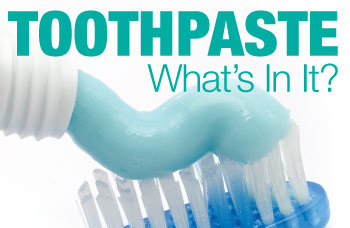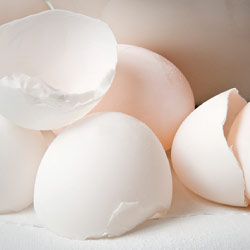Toothpaste — What's In It?
Squeezing out the facts

Brushing one's teeth has, for hundreds of years, been a hygienic and social necessity. Removing the bacterial biofilm, or plaque, that builds up on clean teeth every 12 to 24 hours helps prevent tooth decay, gum disease, and bad breath. None of us would think of leaving the house before brushing with a favourite toothpaste — unless, of course, we ran out. Then we would make a beeline for the nearest drug store rather than improvise for even one brushing! But what's in this substance we put in our mouths several times a day? And can toothpastes really do what they claim to do?
The short answer to that second question is yes — if the American Dental Association Seal of Acceptance is on the label. That seal means the manufacturer's claims have been independently verified. If you don't see the seal, you might want to take a closer look at the ingredients list. As you compare labels, you will notice that certain terms appear frequently.
Toothpaste Demystified
There are various classes of ingredients you will find in all toothpastes, and others only in products designed for specific purposes such as reducing sensitivity, tartar or gum inflammation, or even whitening your teeth.
Here are some things to look for:
 |
| Egyptians scrubbed their teeth with a mixture of ox-hoof ashes, burnt eggshells and pumice as far back as 5000 BC. |
One of the main points of using toothpaste is to make the mechanical action of brushing more effective. In order to scrub off stains, you need a substance with a little graininess. This has been understood since ancient times; Egyptians scrubbed their teeth with a mixture of ox-hoof ashes, burnt eggshells and pumice as far back as 5000 BC. Ancient Romans used an even rougher blend of crushed bones and oyster shells, plus powdered charcoal and bark. Even in the 18th century AD, the British were including brick dust and crushed China in their tooth powder recipes.
Abrasives (commonly called cleaning and polishing agents) in toothpastes have been produced that are much milder since then, the idea being to clean yet preserve tooth enamel. In fact, toothpastes are tested to see if the abrasive component can remove stains without damaging tooth structure. The degree of abrasiveness of a given compound depends on how much water it contains (also known as the level of hydration), the size and shape of its particles, source, purity, and how it has been treated both physically and chemically. Ideally, abrasives should be inert chemically, meaning they will not form new compounds with other substances in the toothpaste. Today, the abrasives you might find in your toothpaste include hydrated silica (which can be made from sand), hydrated alumina, calcium carbonate, and dicalcium phosphates. None of these materials would have any cleaning effect on teeth without the scrubbing action of a toothbrush. Likewise, brushing teeth without an abrasive-containing toothpaste will not adequately clean and polish the tooth surfaces and will not remove stains.
Detergents
Your toothpaste foams because it contains a detergent, another type of cleaning ingredient. The purpose of a detergent is to loosen and break down substances on your teeth that would otherwise not be soluble, meaning they could not be dissolved and rinsed away with water. Although we might associate the word “detergent” with harsher cleaning products, detergents in toothpastes are mild so as not to irritate sensitive oral tissues.
Detergents are also known as “surfactants,” short for surface active agents. They are able to break through the tension at the surface of a liquid. Surface tension is the property that makes a fluid appear as if it has a skin — noticeable when dust or even denser materials settle or float on it. The way soap breaks down grease is an example of surfactant action.
The most common detergent/surfactant in toothpaste is sodium lauryl sulfate. You may have noticed it in other beauty products that foam, such as shampoo. This ingredient can be derived from coconut or palm kernel oil. While there have been internet rumors that sodium lauryl sulfate is dangerous, these claims are unsubstantiated by scientific research. This detergent has actually been used safely in toothpaste for more than 50 years. One credible concern, according to the Journal of the American Dental Association, is increased oral irritation in people prone to canker sores. These individuals should be aware that it is possible to buy toothpaste without sodium lauryl sulfate.
Fluoride
First introduced into toothpaste formulas in 1914, fluoride is arguably the most valuable component in toothpaste. But it was not until the 1950's that formulations were developed in which the fluoride was available to react with tooth enamel. Marketing of the first effective fluoride toothpaste (Crest) began in February 1955 and was accepted by the American Dental Association in 1960. Fluoride serves an extremely important function: to strengthen tooth enamel and make teeth more resistant to decay. Fluoride is actually incorporated into the enamel structure. If the enamel surface of a tooth is exposed to acid either ingested or produced by oral bacteria, the affected surface can absorb fluoride if present, thereby helping to reverse the process. This not only “remineralizes” the affected surface, but actually makes it stronger and more resistant to acid attack (with repeated and frequent application). Tooth enamel strengthened with fluoride is also more resistant to acid attack in the first place. All toothpastes that carry the American Dental Association Seal of Acceptance contain fluoride and have been shown to be effective in preventing dental decay. You will find fluoride in toothpaste in the form of sodium fluoride, stannous fluoride or sodium monofluorophosphate (MFP). [NOTE: Fluoride)“containing toothpastes do not need a preservative as the fluoride inhibits bacterial growth.]
Humectant Systems
This refers to a combination of ingredients that retain moisture in the toothpaste (humectants) and keep all the ingredients from separating (binding agents). If toothpaste didn't have these components, it would dry out or require stirring before use just like paint. Here are some common components of humectant systems:
- Humectants: glycerol, propylene glycol and sorbitol.
- Binders: Carrageenan (seaweed gum), gum arabic (sap from the Acacia tree), sodium carboxymethylcellulose and magnesium aluminum silicate (both synthetics).
- Preservatives for non-fluoride toothpastes: sodium benzoate, methyl paraben, ethyl paraben (gentle antimicrobial agents used as preservatives in foods, beverages and cosmetics).
The ADA will not put its seal on toothpastes that contain sugar or any other ingredient that promotes tooth decay.
Toothpaste would taste pretty bad without the addition of flavouring agents, which is why you will always find various natural and artificial flavourings and sweeteners such as saccharin. The humectant sorbitol also adds a sweet taste. The ADA will not put its seal on toothpastes that contain sugar or any other ingredient that promotes tooth decay.
Additional Therapeutic Ingredients
While the above list applies to all toothpastes, other ingredients will appear on the labels of toothpastes designed for specific purposes.
For other interesting and informative dental articles, visit this site http://www.deardoctor.com
No comments:
Post a Comment